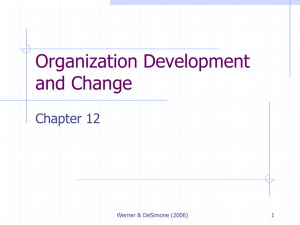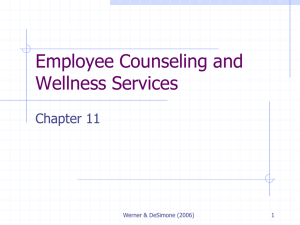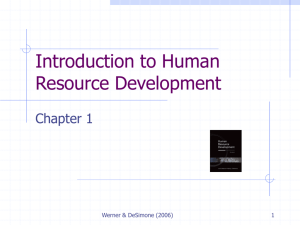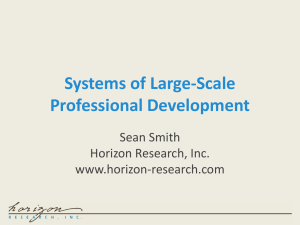Chapter 8 - ernitaniusbiz
advertisement
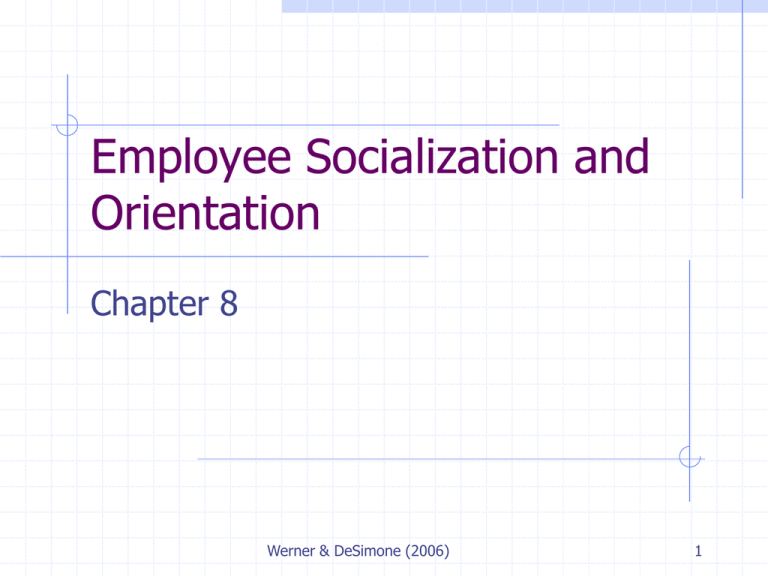
Employee Socialization and Orientation Chapter 8 Werner & DeSimone (2006) 1 Learning Objectives After learning this chapter, you should be able to: Discuss the content, outcomes, and process of organizational socialization. Discuss the models and two approaches to socialization. State the challenges faced by new employees entering an organization and the things they need to be successful. Describe the realistic job preview approach to recruiting and explain how it can benefit organizations and new employees. Define and explain the goals of employee orientation. Explain the common problems in employee orientation. Identify the characteristics of an effective orientation programs. Learn the key elements in designing, implementing, and evaluating an effective orientation program. Werner & DeSimone (2006) 2 Organizational Socialization How employees adjust to a new organization What is at stake: Employee satisfaction, commitment, and performance Work group satisfaction and performance Start-up costs for new employee Likelihood of retention Replacement costs Werner & DeSimone (2006) 3 Two Approaches to Socialization Realistic Job Preview (RJP) Employee Orientation Werner & DeSimone (2006) 4 Organizational Socialization Defined “The process by which an individual acquires the social knowledge and skills necessary to assume an organizational role.” Werner & DeSimone (2006) 5 Organizational Role A set of behaviors expected of individuals who hold a given position in a group. Werner & DeSimone (2006) 6 Dimensions of Organizational Roles Inclusionary – social dimension (e.g., outsider, probationary, permanent status) Functional – task dimension (e.g., sales, engineering, administrative) Hierarchical – rank dimension (e.g., line employee, supervisor, management, officer) Werner & DeSimone (2006) 7 Role Situations Role – a set of behaviors expected of individuals holding a given position in a group Role overload – more than can be reasonably expected from an individual Role conflict – unclear expectations from others – mix massages Role ambiguity – role itself is unclear Common in newly created positions It relates to stress – relate to job satisfaction, job performance, turnover, absenteeism Werner & DeSimone (2006) 8 Socialization Categories Preliminary learning Learning about the organization Learning to function in the work group Learning to perform the job Personal learning Werner & DeSimone (2006) 9 Feldman’s Stage Model of Socialization Three stages: Anticipatory socialization Encounter Change and Acquisition Werner & DeSimone (2006) 10 Feldman’s Model of Organizational Socialization By Permission: Feldman (1981) Werner & DeSimone (2006) 11 Anticipatory Socialization Setting of realistic expectations Determining a match with newcomer Werner & DeSimone (2006) 12 Encounter Formal commitment made to join the organization “Breaking in” (initiation into the job) Establishing relationships Roles clarified Werner & DeSimone (2006) 13 Change and Acquisition New employee accepts group norms and values Employee masters tasks Employee resolves any role conflicts and overloads Werner & DeSimone (2006) 14 What Do Newcomers Need? Clear information on: Expectations Norms Roles Values Assistance in developing needed KSAOs Accurate help in interpreting events Werner & DeSimone (2006) 15 Effects of Realistic Job Preview By Permission: Wanous (1978) Werner & DeSimone (2006) 16 The Realistic Job Preview Provide recruits with complete information about job & organization - +ve & -ve aspects Vaccination Against Unrealistically High Expectationscan adjust their expectation towards the job Self-Selection Does it meet individual and job needs? Coping Effect Develops coping strategies to perform their job effectively Personal Commitment Based on personal choice – employee will stay, satisfy, comitted Werner & DeSimone (2006) 17 When to Use Realistic Job Previews (RJPs) When candidates can be selective about jobs When there are more applicants than jobs When recruits lack necessary information When replacement costs are high Werner & DeSimone (2006) 18 Issues in RJP Content Descriptive or Judgmental Content Facts or feelings? Extensive or Intensive Content All information stressed, or pertinent only? Degree of Content Negativity Positive or negative approach? Message Source Actors or company members? Werner & DeSimone (2006) 19 Employee Orientation Programs Reduce newcomer stress Reduce start-up costs Reduce turnover Expedite/speed up proficiency Assist in newcomer assimilation Enhance adjustment to work group and norms Encourage positive attitude Werner & DeSimone (2006) 20 Orientation Program Content Information about company as a whole Job-specific information Werner & DeSimone (2006) 21 Company Information Overview of company Key policies and procedures Mission statement Company goals and strategy Compensation, benefits, safety Employee relations Company facilities Werner & DeSimone (2006) 22 Job-Specific Information Department functions Job duties and responsibilities Polices, rules, and procedures Tour of department Introduction to departmental employees Introduction to work group Werner & DeSimone (2006) 23 A Large Company Procedure (Table 8-4) Material distribution Pre-arrival period First day First week Second week Periodic updates Werner & DeSimone (2006) 24 Orientation Roles Supervisor Information source Guide for new employees Coworkers Socialize into organization Help learn norms of the work group and organization Werner & DeSimone (2006) 25 Orientation and the HRD Staff HRD staff designs and implements new employee orientation program HRD schedules participation by various level of management HRD staff evaluates orientation program and implements needed changes Werner & DeSimone (2006) 26 Common Problems in Employee Orientation Too much paperwork Information overload Information irrelevance Scare tactics Too much “selling” of the organization Werner & DeSimone (2006) 27 Common Problems in Employee Orientation – 2 Too much one-way communication One-shot mentality No evaluation of program Lack of follow-up Werner & DeSimone (2006) 28 Designing and Implementing an Orientation Program Set objectives Research orientation as a concept Interview recent new hires Survey other company practices Review existing practices Select content and delivery method Pilot and revise materials Werner & DeSimone (2006) 29 Designing and Implementing an Orientation Program – 2 Produce and package the printed and audiovisual materials Train supervisors and install program Evaluate program effectiveness Improve and update program Werner & DeSimone (2006) 30 Summary New employees face many challenges Realistic job previews and employee orientation programs can: Reduce stress Reduce turnover Improve productivity Werner & DeSimone (2006) 31
